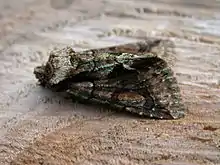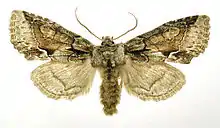Allophyes oxyacanthae
Allophyes oxyacanthae, the green-brindled crescent, is a moth of the family Noctuidae. The species was first described by Carl Linnaeus in his landmark 1758 10th edition of Systema Naturae. It is found in Europe.
| Allophyes oxyacanthae | |
|---|---|
 | |
 | |
| Scientific classification | |
| Kingdom: | |
| Phylum: | |
| Class: | |
| Order: | |
| Family: | |
| Genus: | |
| Species: | A. oxyacanthae |
| Binomial name | |
| Allophyes oxyacanthae | |
Technical description and variation
M. oxyacanthae L. (31 g). Forewing reddish grey, varied with fuscous; the nervures and inner margin lined with green scales; a strong black streak from base below cell; lines finely black, the inner sharply angled outwards at the end of the basal streak, the outer marked with a bright white crescent on submedian fold; stigmata all large, pale pinky brown, outlined with black; a diffuse black shade to termen below vein 2; submarginal line faintly paler, the area before it generally paler; hindwing luteous whitish in male, grey in female. The form found in Syria, benedictina Stgr. (31 g) [now full species Allophyes benedictina (Staudinger, [1892]) ]has the forewings dark grey brown; the hindwings paler; but those of the female are darker grey; — another form, occurring in Pontus, Palestine and Ussuriland , asiatica Stgr.[ now full species Allophyes asiatica (Staudinger, [1892]) has the fore-wings pale grey; capucina Mill. (31 g h) is a form restricted, apparently, to the British Isles, rich deep brown with darker shading in the male, darker duller brown in the female, with the lines and markings distinct, the hindwings of the male often rufous-tinged; in this the green scaling is altogether absent; — corsica Spul. [now full species Allophyes corsica (Spuler, 1905)] from the Island of Corsica is said to be paler, of a more vivid yellowish red colour; — pallida Tutt, from Ireland and Berkshire, has pale reddish grey forewings, with only a slight amount of green along inner and outer margins. Larva dull slaty grey or brownish grey, covered with irregular-shaped black marks; on each side of segment 4, which is slightly raised, an oblique dark streak; tubercles pale on dark spots; spiracles fine, white, with black rings.[1] The wingspan is 35–45 mm.
Biology
The moth flies from September to November, depending on the location.
The larvae feed on Crataegus, Prunus spinosa, birch and various fruit bearing trees.[2]
Gallery
.jpg.webp) Young larva
Young larva.jpg.webp) Larva
Larva.jpg.webp) Pupa
Pupa.jpg.webp) Adult
Adult
References
- Warren. W. in Seitz, A. Ed., 1914 Die Großschmetterlinge der Erde, Verlag Alfred Kernen, Stuttgart Band 3: Abt. 1, Die Großschmetterlinge des palaearktischen Faunengebietes, Die palaearktischen eulenartigen Nachtfalter, 1914
 This article incorporates text from this source, which is in the public domain.
This article incorporates text from this source, which is in the public domain. - Robinson, Gaden S.; Ackery, Phillip R.; Kitching, Ian J.; Beccaloni, George W. & Hernández, Luis M. (2010). "Search the database - introduction and help". HOSTS - A Database of the World's Lepidopteran Hostplants. Natural History Museum, London.
External links
| Wikimedia Commons has media related to Allophyes oxyacanthae. |
- Kimber, Ian. "73.068 BF2245 Green-brindled Crescent Allophyes oxyacanthae (Linnaeus, 1758)". UKMoths. Retrieved 22 January 2021.
- Fauna Europaea
- Savela, Markku, ed. (May 5, 2020). "Allophyes oxyacanthae (Linnaeus, 1758)". Lepidoptera and Some Other Life Forms. Retrieved January 22, 2021.
- "Allophyes oxyacanthae (Linnaeus, 1758)". Catalogue of the Lepidoptera of Belgium. Archived from the original on May 12, 2017.
- "09682 Allophyes oxyacanthae (Linnaeus, 1758) - Weißdorneule". Lepiforum e. V. Retrieved January 22, 2021. (in German)
- [https://www.vlinderstichting.nl/vlinders/overzicht-vlinders/details-vlinder/meidoornuil "Meidoornuil
Allophyes oxyacanthae"]. De Vlinderstichting. Retrieved January 22, 2021. (in Dutch)